University of the Cumberlands: Starbucks Strategic Case Study, BUOL638
VerifiedAdded on 2022/11/15
|31
|7700
|254
Case Study
AI Summary
This case study provides a comprehensive analysis of Starbucks Corporation's strategic management, focusing on its internal and external environments. The report begins with an executive summary highlighting key findings, including the identification of both internal and external threats and weaknesses such as high pricing and intense competition. A detailed PESTLE analysis examines the political, economic, social, technological, legal/regulatory, and environmental factors impacting Starbucks. Porter's Five Forces analysis assesses the industry landscape, including the bargaining power of suppliers and customers, the threat of new entrants and substitutes, and the intensity of competitive rivalry. The study then delves into the firm's mission, vision, strengths, financial condition, constraints, management philosophy, and organizational structure. The product analysis covers goods and services, customer needs, and marketing strategies. A SWOT analysis identifies strengths, weaknesses, opportunities, and threats. The study concludes with a problem statement and a five-year strategic plan, including vision, mission, objectives, strategies, and an implementation plan with key performance indicators (KPIs). References are provided to support the analysis.
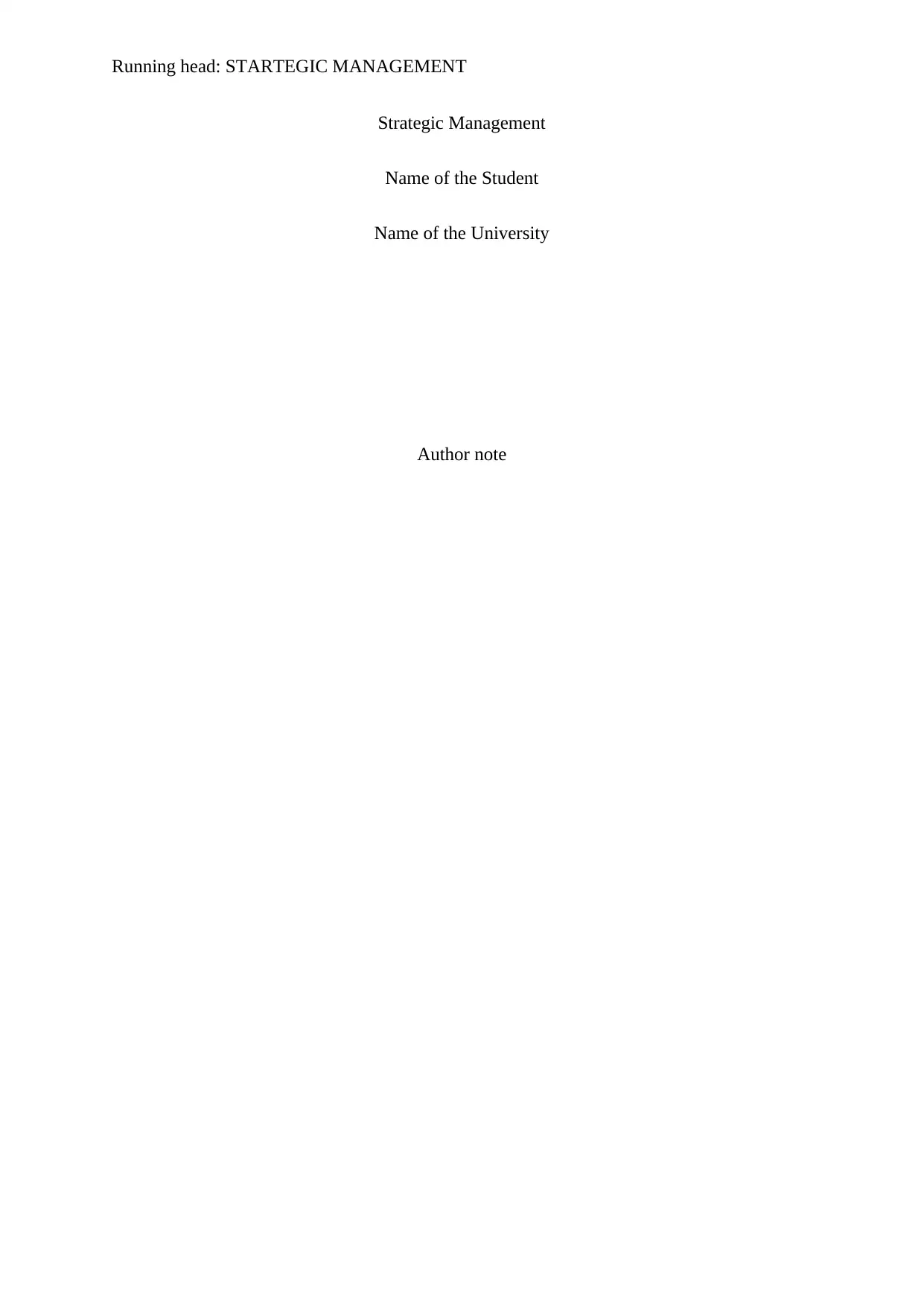
Running head: STARTEGIC MANAGEMENT
Strategic Management
Name of the Student
Name of the University
Author note
Strategic Management
Name of the Student
Name of the University
Author note
Paraphrase This Document
Need a fresh take? Get an instant paraphrase of this document with our AI Paraphraser

1STARTEGIC MANAGEMENT
Executive Summary
The report has thrown light on identifying and analyzing the internal and external
environmental analysis of Starbucks Corporation. From the analysis of the case study, it has
been identified that there are different kinds of threats and weaknesses internally and
externally such as high pricing strategy along with high level of competition has affected the
growth of the company negatively.
In such scenario, despite the positive outlook of the market of Starbucks, the company needed
to create a proper strategic planning and counseling as they faced the different challenges
related to the competition such as McDonald’s and other companies are growing by
providing the similar kind of products at a cheaper rate. Despite heavy challenges faced by
Starbucks, the analysis has been able to showcase the facts that Starbucks is well-positioned
in the market that has been helpful for the growth of the company in a positive manner.
The report has been meant to be the strategic kind of pathfinder which mainly aims at
illuminating the different kinds of strategic alternatives in the light of the different
opportunities along with threats that lie ahead in the long run. Moreover, the report has
provided with the proper utilization of the different strengths and opportunities which could
be used as the Key Performance Indicators in solving the issues and minimize the different
threats in a successful manner.
Executive Summary
The report has thrown light on identifying and analyzing the internal and external
environmental analysis of Starbucks Corporation. From the analysis of the case study, it has
been identified that there are different kinds of threats and weaknesses internally and
externally such as high pricing strategy along with high level of competition has affected the
growth of the company negatively.
In such scenario, despite the positive outlook of the market of Starbucks, the company needed
to create a proper strategic planning and counseling as they faced the different challenges
related to the competition such as McDonald’s and other companies are growing by
providing the similar kind of products at a cheaper rate. Despite heavy challenges faced by
Starbucks, the analysis has been able to showcase the facts that Starbucks is well-positioned
in the market that has been helpful for the growth of the company in a positive manner.
The report has been meant to be the strategic kind of pathfinder which mainly aims at
illuminating the different kinds of strategic alternatives in the light of the different
opportunities along with threats that lie ahead in the long run. Moreover, the report has
provided with the proper utilization of the different strengths and opportunities which could
be used as the Key Performance Indicators in solving the issues and minimize the different
threats in a successful manner.
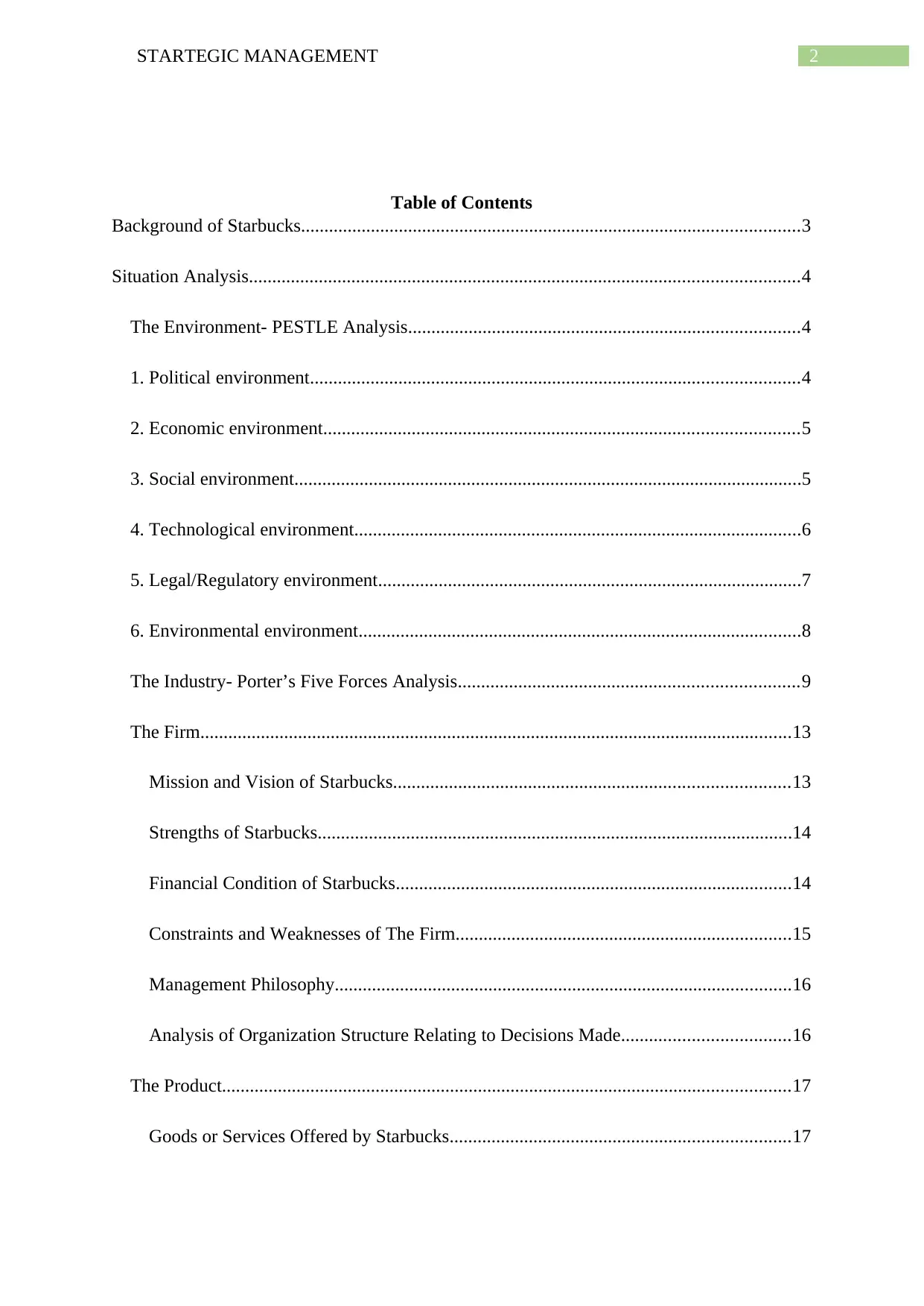
2STARTEGIC MANAGEMENT
Table of Contents
Background of Starbucks...........................................................................................................3
Situation Analysis......................................................................................................................4
The Environment- PESTLE Analysis....................................................................................4
1. Political environment.........................................................................................................4
2. Economic environment......................................................................................................5
3. Social environment.............................................................................................................5
4. Technological environment................................................................................................6
5. Legal/Regulatory environment...........................................................................................7
6. Environmental environment...............................................................................................8
The Industry- Porter’s Five Forces Analysis.........................................................................9
The Firm...............................................................................................................................13
Mission and Vision of Starbucks.....................................................................................13
Strengths of Starbucks......................................................................................................14
Financial Condition of Starbucks.....................................................................................14
Constraints and Weaknesses of The Firm........................................................................15
Management Philosophy..................................................................................................16
Analysis of Organization Structure Relating to Decisions Made....................................16
The Product..........................................................................................................................17
Goods or Services Offered by Starbucks.........................................................................17
Table of Contents
Background of Starbucks...........................................................................................................3
Situation Analysis......................................................................................................................4
The Environment- PESTLE Analysis....................................................................................4
1. Political environment.........................................................................................................4
2. Economic environment......................................................................................................5
3. Social environment.............................................................................................................5
4. Technological environment................................................................................................6
5. Legal/Regulatory environment...........................................................................................7
6. Environmental environment...............................................................................................8
The Industry- Porter’s Five Forces Analysis.........................................................................9
The Firm...............................................................................................................................13
Mission and Vision of Starbucks.....................................................................................13
Strengths of Starbucks......................................................................................................14
Financial Condition of Starbucks.....................................................................................14
Constraints and Weaknesses of The Firm........................................................................15
Management Philosophy..................................................................................................16
Analysis of Organization Structure Relating to Decisions Made....................................16
The Product..........................................................................................................................17
Goods or Services Offered by Starbucks.........................................................................17
⊘ This is a preview!⊘
Do you want full access?
Subscribe today to unlock all pages.

Trusted by 1+ million students worldwide

3STARTEGIC MANAGEMENT
Analysis of Needs of Customers Solved by Starbucks....................................................17
Analysis of Promotional Mix, Channels of Distribution and Pricing Strategies Used by
Starbucks..........................................................................................................................18
Analysis of Competitive Advantage Offered by Marketing Strategy..............................18
SWOT Analysis...................................................................................................................19
Problem Statement...................................................................................................................20
Strategic Plan...........................................................................................................................21
Development of 5-year Strategic Plan for Starbucks...........................................................21
Clear Vision, Mission and Core Values...........................................................................21
SMART Objectives to Solve Problem.............................................................................21
Corresponding Strategies for Objectives Identified.........................................................22
Implementation Plan........................................................................................................22
Key Performance Indicators to Monitor Progress............................................................23
Summary..................................................................................................................................23
References................................................................................................................................25
Analysis of Needs of Customers Solved by Starbucks....................................................17
Analysis of Promotional Mix, Channels of Distribution and Pricing Strategies Used by
Starbucks..........................................................................................................................18
Analysis of Competitive Advantage Offered by Marketing Strategy..............................18
SWOT Analysis...................................................................................................................19
Problem Statement...................................................................................................................20
Strategic Plan...........................................................................................................................21
Development of 5-year Strategic Plan for Starbucks...........................................................21
Clear Vision, Mission and Core Values...........................................................................21
SMART Objectives to Solve Problem.............................................................................21
Corresponding Strategies for Objectives Identified.........................................................22
Implementation Plan........................................................................................................22
Key Performance Indicators to Monitor Progress............................................................23
Summary..................................................................................................................................23
References................................................................................................................................25
Paraphrase This Document
Need a fresh take? Get an instant paraphrase of this document with our AI Paraphraser

4STARTEGIC MANAGEMENT
Background of Starbucks
Starbucks Corporation is one of the Multinational Company that mainly specializes in
the sales and production of the different coffee related products which is inclusive of the roast
coffee along with the other coffee related products and drinks globally. The company was
incorporated in the year 1987 as the coffee roasting organization situated in Seattle,
Washington by the three major owners who tried to learn the concept of preparing the coffee
and roasting from the local Italian retailer. In the current scenario, the respective company is
operating in more than 30000 locations in the worldwide. The number of employees working
in the company is 291000 till the year 2018 and it has helped the company in gaining
profitability in a successful manner (Starbucks.com, 2019). Moreover, the revenue which has
been earned by Starbucks is US$24.71 billion till the year 2018 and in the present scenario,
Starbucks uses automated espresso machines for safety reasons along with efficiency.
In order to achieve the strategic goals of the expansion of the business which helps
them in serving the demands of the customers in the market of the hospitality industry,
Starb0ucks adopted the different strategies wherein the main aim and objective was aimed at
increasing the overall productivity which helped in increasing the output related to sales in a
positive manner. The major strategy which was involved was the proper expansion of
business of Starbucks through opening the several outlets in United States and in other
countries within the year 2010 ((Starbucks.com, 2019). Additionally, the respective company
has been able to adopt the different internal strategies related to business for improving the
overall productivity wherein the main focus was on the welfare of the different employees
who are employed with Starbucks.
The analysis of the case study helps in analyzing the different steps that Starbucks
Corporation has adopted their effort which assists them in expanding the business operations
Background of Starbucks
Starbucks Corporation is one of the Multinational Company that mainly specializes in
the sales and production of the different coffee related products which is inclusive of the roast
coffee along with the other coffee related products and drinks globally. The company was
incorporated in the year 1987 as the coffee roasting organization situated in Seattle,
Washington by the three major owners who tried to learn the concept of preparing the coffee
and roasting from the local Italian retailer. In the current scenario, the respective company is
operating in more than 30000 locations in the worldwide. The number of employees working
in the company is 291000 till the year 2018 and it has helped the company in gaining
profitability in a successful manner (Starbucks.com, 2019). Moreover, the revenue which has
been earned by Starbucks is US$24.71 billion till the year 2018 and in the present scenario,
Starbucks uses automated espresso machines for safety reasons along with efficiency.
In order to achieve the strategic goals of the expansion of the business which helps
them in serving the demands of the customers in the market of the hospitality industry,
Starb0ucks adopted the different strategies wherein the main aim and objective was aimed at
increasing the overall productivity which helped in increasing the output related to sales in a
positive manner. The major strategy which was involved was the proper expansion of
business of Starbucks through opening the several outlets in United States and in other
countries within the year 2010 ((Starbucks.com, 2019). Additionally, the respective company
has been able to adopt the different internal strategies related to business for improving the
overall productivity wherein the main focus was on the welfare of the different employees
who are employed with Starbucks.
The analysis of the case study helps in analyzing the different steps that Starbucks
Corporation has adopted their effort which assists them in expanding the business operations
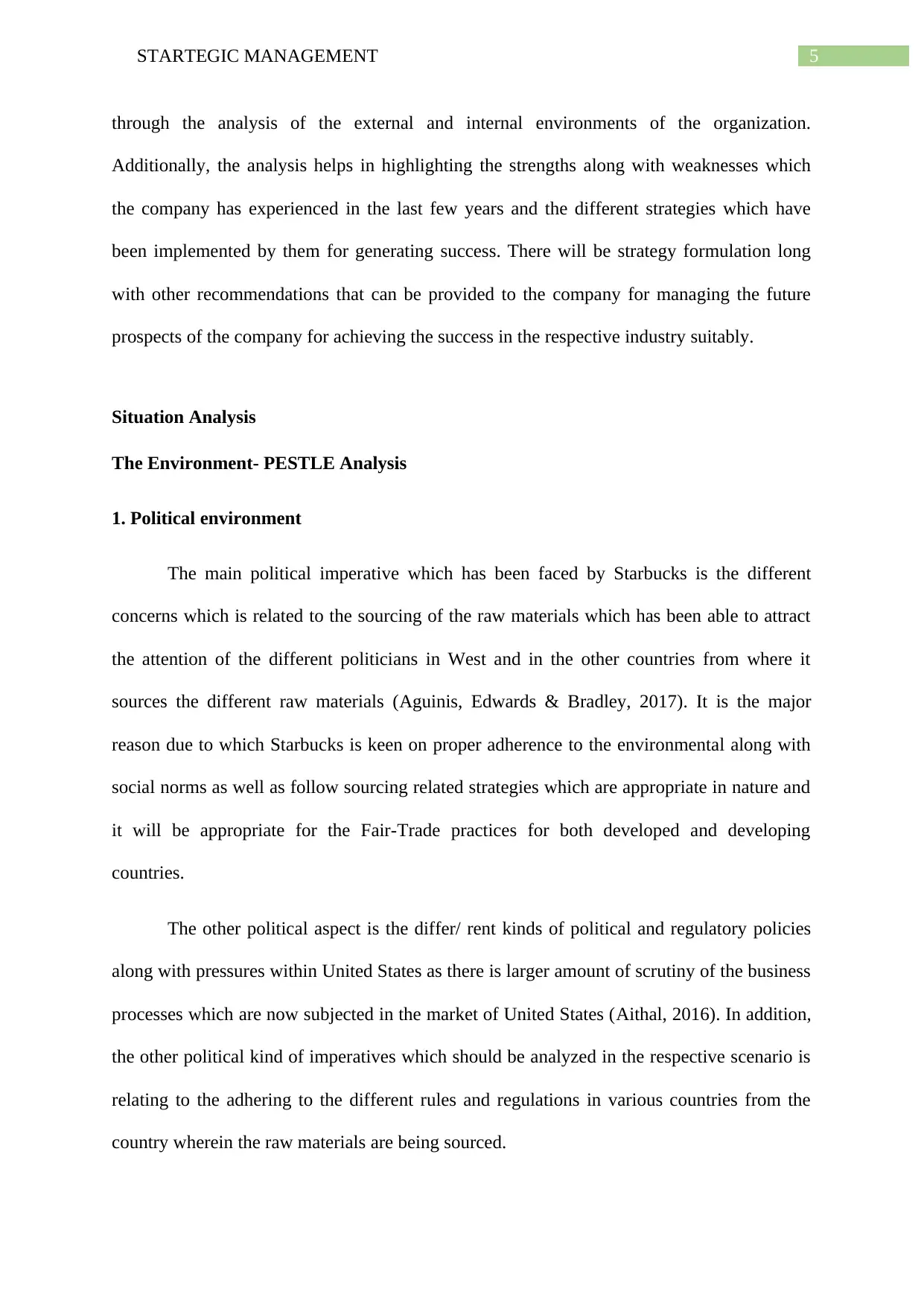
5STARTEGIC MANAGEMENT
through the analysis of the external and internal environments of the organization.
Additionally, the analysis helps in highlighting the strengths along with weaknesses which
the company has experienced in the last few years and the different strategies which have
been implemented by them for generating success. There will be strategy formulation long
with other recommendations that can be provided to the company for managing the future
prospects of the company for achieving the success in the respective industry suitably.
Situation Analysis
The Environment- PESTLE Analysis
1. Political environment
The main political imperative which has been faced by Starbucks is the different
concerns which is related to the sourcing of the raw materials which has been able to attract
the attention of the different politicians in West and in the other countries from where it
sources the different raw materials (Aguinis, Edwards & Bradley, 2017). It is the major
reason due to which Starbucks is keen on proper adherence to the environmental along with
social norms as well as follow sourcing related strategies which are appropriate in nature and
it will be appropriate for the Fair-Trade practices for both developed and developing
countries.
The other political aspect is the differ/ rent kinds of political and regulatory policies
along with pressures within United States as there is larger amount of scrutiny of the business
processes which are now subjected in the market of United States (Aithal, 2016). In addition,
the other political kind of imperatives which should be analyzed in the respective scenario is
relating to the adhering to the different rules and regulations in various countries from the
country wherein the raw materials are being sourced.
through the analysis of the external and internal environments of the organization.
Additionally, the analysis helps in highlighting the strengths along with weaknesses which
the company has experienced in the last few years and the different strategies which have
been implemented by them for generating success. There will be strategy formulation long
with other recommendations that can be provided to the company for managing the future
prospects of the company for achieving the success in the respective industry suitably.
Situation Analysis
The Environment- PESTLE Analysis
1. Political environment
The main political imperative which has been faced by Starbucks is the different
concerns which is related to the sourcing of the raw materials which has been able to attract
the attention of the different politicians in West and in the other countries from where it
sources the different raw materials (Aguinis, Edwards & Bradley, 2017). It is the major
reason due to which Starbucks is keen on proper adherence to the environmental along with
social norms as well as follow sourcing related strategies which are appropriate in nature and
it will be appropriate for the Fair-Trade practices for both developed and developing
countries.
The other political aspect is the differ/ rent kinds of political and regulatory policies
along with pressures within United States as there is larger amount of scrutiny of the business
processes which are now subjected in the market of United States (Aithal, 2016). In addition,
the other political kind of imperatives which should be analyzed in the respective scenario is
relating to the adhering to the different rules and regulations in various countries from the
country wherein the raw materials are being sourced.
⊘ This is a preview!⊘
Do you want full access?
Subscribe today to unlock all pages.

Trusted by 1+ million students worldwide
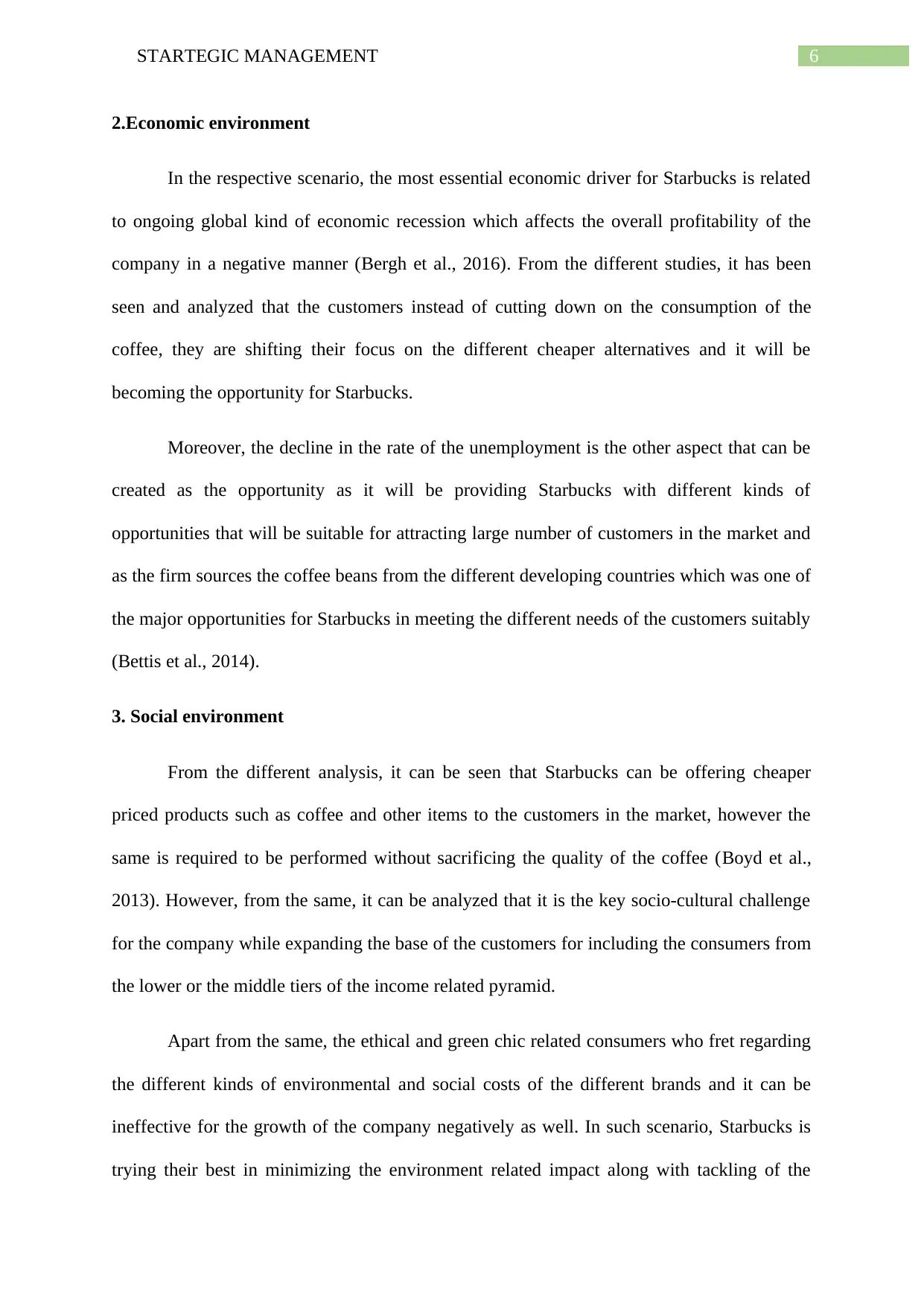
6STARTEGIC MANAGEMENT
2.Economic environment
In the respective scenario, the most essential economic driver for Starbucks is related
to ongoing global kind of economic recession which affects the overall profitability of the
company in a negative manner (Bergh et al., 2016). From the different studies, it has been
seen and analyzed that the customers instead of cutting down on the consumption of the
coffee, they are shifting their focus on the different cheaper alternatives and it will be
becoming the opportunity for Starbucks.
Moreover, the decline in the rate of the unemployment is the other aspect that can be
created as the opportunity as it will be providing Starbucks with different kinds of
opportunities that will be suitable for attracting large number of customers in the market and
as the firm sources the coffee beans from the different developing countries which was one of
the major opportunities for Starbucks in meeting the different needs of the customers suitably
(Bettis et al., 2014).
3. Social environment
From the different analysis, it can be seen that Starbucks can be offering cheaper
priced products such as coffee and other items to the customers in the market, however the
same is required to be performed without sacrificing the quality of the coffee (Boyd et al.,
2013). However, from the same, it can be analyzed that it is the key socio-cultural challenge
for the company while expanding the base of the customers for including the consumers from
the lower or the middle tiers of the income related pyramid.
Apart from the same, the ethical and green chic related consumers who fret regarding
the different kinds of environmental and social costs of the different brands and it can be
ineffective for the growth of the company negatively as well. In such scenario, Starbucks is
trying their best in minimizing the environment related impact along with tackling of the
2.Economic environment
In the respective scenario, the most essential economic driver for Starbucks is related
to ongoing global kind of economic recession which affects the overall profitability of the
company in a negative manner (Bergh et al., 2016). From the different studies, it has been
seen and analyzed that the customers instead of cutting down on the consumption of the
coffee, they are shifting their focus on the different cheaper alternatives and it will be
becoming the opportunity for Starbucks.
Moreover, the decline in the rate of the unemployment is the other aspect that can be
created as the opportunity as it will be providing Starbucks with different kinds of
opportunities that will be suitable for attracting large number of customers in the market and
as the firm sources the coffee beans from the different developing countries which was one of
the major opportunities for Starbucks in meeting the different needs of the customers suitably
(Bettis et al., 2014).
3. Social environment
From the different analysis, it can be seen that Starbucks can be offering cheaper
priced products such as coffee and other items to the customers in the market, however the
same is required to be performed without sacrificing the quality of the coffee (Boyd et al.,
2013). However, from the same, it can be analyzed that it is the key socio-cultural challenge
for the company while expanding the base of the customers for including the consumers from
the lower or the middle tiers of the income related pyramid.
Apart from the same, the ethical and green chic related consumers who fret regarding
the different kinds of environmental and social costs of the different brands and it can be
ineffective for the growth of the company negatively as well. In such scenario, Starbucks is
trying their best in minimizing the environment related impact along with tackling of the
Paraphrase This Document
Need a fresh take? Get an instant paraphrase of this document with our AI Paraphraser
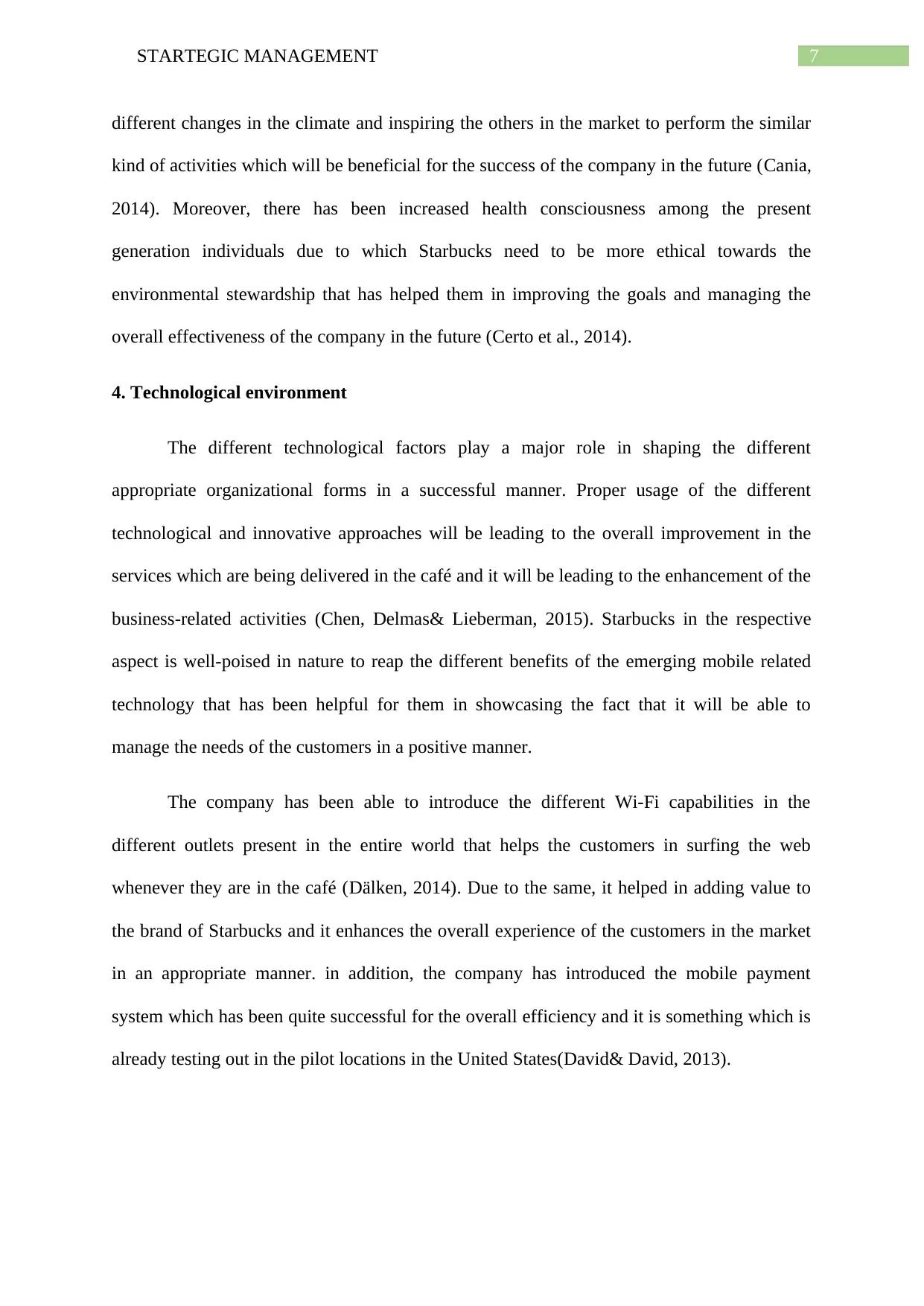
7STARTEGIC MANAGEMENT
different changes in the climate and inspiring the others in the market to perform the similar
kind of activities which will be beneficial for the success of the company in the future (Cania,
2014). Moreover, there has been increased health consciousness among the present
generation individuals due to which Starbucks need to be more ethical towards the
environmental stewardship that has helped them in improving the goals and managing the
overall effectiveness of the company in the future (Certo et al., 2014).
4. Technological environment
The different technological factors play a major role in shaping the different
appropriate organizational forms in a successful manner. Proper usage of the different
technological and innovative approaches will be leading to the overall improvement in the
services which are being delivered in the café and it will be leading to the enhancement of the
business-related activities (Chen, Delmas& Lieberman, 2015). Starbucks in the respective
aspect is well-poised in nature to reap the different benefits of the emerging mobile related
technology that has been helpful for them in showcasing the fact that it will be able to
manage the needs of the customers in a positive manner.
The company has been able to introduce the different Wi-Fi capabilities in the
different outlets present in the entire world that helps the customers in surfing the web
whenever they are in the café (Dälken, 2014). Due to the same, it helped in adding value to
the brand of Starbucks and it enhances the overall experience of the customers in the market
in an appropriate manner. in addition, the company has introduced the mobile payment
system which has been quite successful for the overall efficiency and it is something which is
already testing out in the pilot locations in the United States(David& David, 2013).
different changes in the climate and inspiring the others in the market to perform the similar
kind of activities which will be beneficial for the success of the company in the future (Cania,
2014). Moreover, there has been increased health consciousness among the present
generation individuals due to which Starbucks need to be more ethical towards the
environmental stewardship that has helped them in improving the goals and managing the
overall effectiveness of the company in the future (Certo et al., 2014).
4. Technological environment
The different technological factors play a major role in shaping the different
appropriate organizational forms in a successful manner. Proper usage of the different
technological and innovative approaches will be leading to the overall improvement in the
services which are being delivered in the café and it will be leading to the enhancement of the
business-related activities (Chen, Delmas& Lieberman, 2015). Starbucks in the respective
aspect is well-poised in nature to reap the different benefits of the emerging mobile related
technology that has been helpful for them in showcasing the fact that it will be able to
manage the needs of the customers in a positive manner.
The company has been able to introduce the different Wi-Fi capabilities in the
different outlets present in the entire world that helps the customers in surfing the web
whenever they are in the café (Dälken, 2014). Due to the same, it helped in adding value to
the brand of Starbucks and it enhances the overall experience of the customers in the market
in an appropriate manner. in addition, the company has introduced the mobile payment
system which has been quite successful for the overall efficiency and it is something which is
already testing out in the pilot locations in the United States(David& David, 2013).
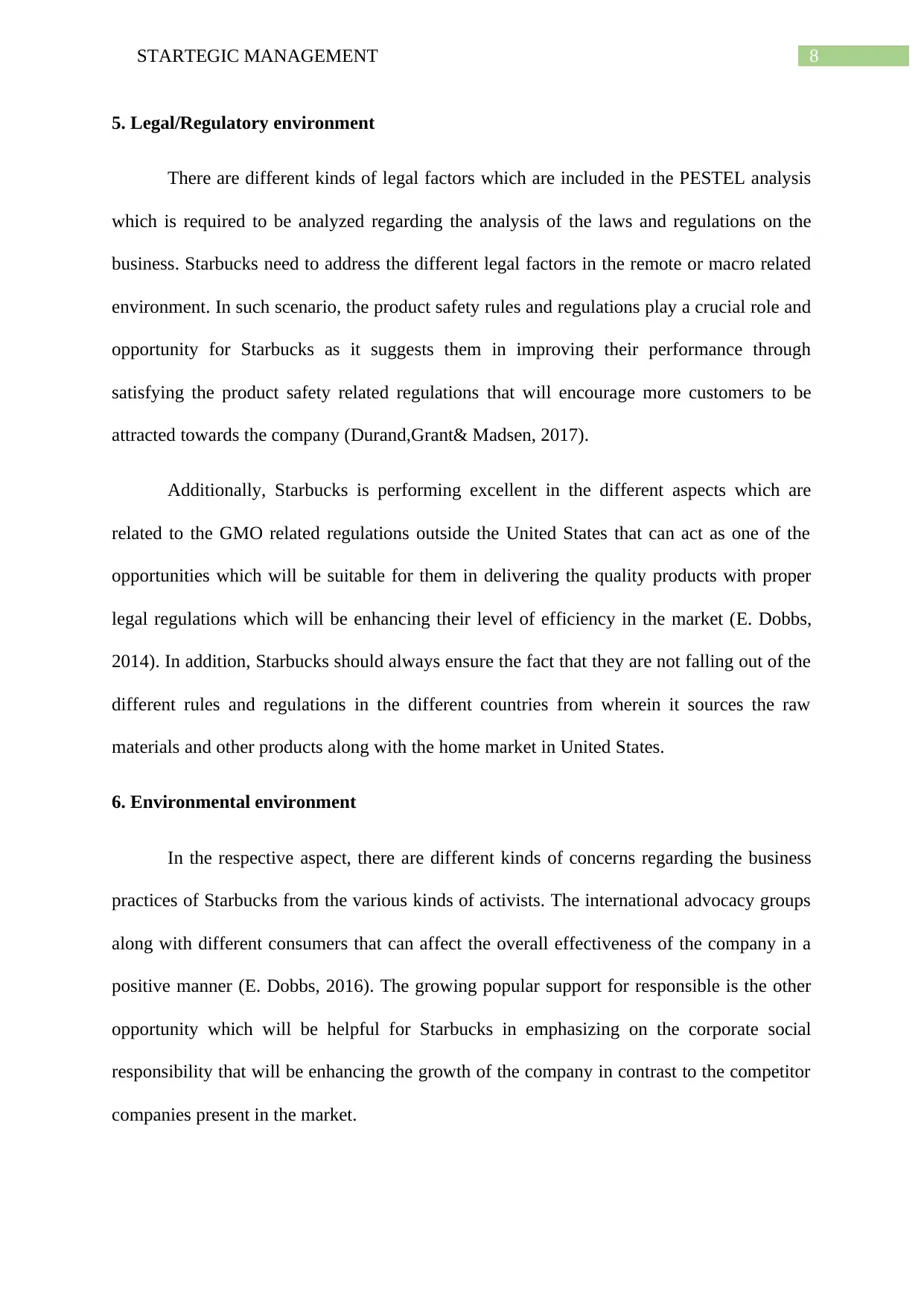
8STARTEGIC MANAGEMENT
5. Legal/Regulatory environment
There are different kinds of legal factors which are included in the PESTEL analysis
which is required to be analyzed regarding the analysis of the laws and regulations on the
business. Starbucks need to address the different legal factors in the remote or macro related
environment. In such scenario, the product safety rules and regulations play a crucial role and
opportunity for Starbucks as it suggests them in improving their performance through
satisfying the product safety related regulations that will encourage more customers to be
attracted towards the company (Durand,Grant& Madsen, 2017).
Additionally, Starbucks is performing excellent in the different aspects which are
related to the GMO related regulations outside the United States that can act as one of the
opportunities which will be suitable for them in delivering the quality products with proper
legal regulations which will be enhancing their level of efficiency in the market (E. Dobbs,
2014). In addition, Starbucks should always ensure the fact that they are not falling out of the
different rules and regulations in the different countries from wherein it sources the raw
materials and other products along with the home market in United States.
6. Environmental environment
In the respective aspect, there are different kinds of concerns regarding the business
practices of Starbucks from the various kinds of activists. The international advocacy groups
along with different consumers that can affect the overall effectiveness of the company in a
positive manner (E. Dobbs, 2016). The growing popular support for responsible is the other
opportunity which will be helpful for Starbucks in emphasizing on the corporate social
responsibility that will be enhancing the growth of the company in contrast to the competitor
companies present in the market.
5. Legal/Regulatory environment
There are different kinds of legal factors which are included in the PESTEL analysis
which is required to be analyzed regarding the analysis of the laws and regulations on the
business. Starbucks need to address the different legal factors in the remote or macro related
environment. In such scenario, the product safety rules and regulations play a crucial role and
opportunity for Starbucks as it suggests them in improving their performance through
satisfying the product safety related regulations that will encourage more customers to be
attracted towards the company (Durand,Grant& Madsen, 2017).
Additionally, Starbucks is performing excellent in the different aspects which are
related to the GMO related regulations outside the United States that can act as one of the
opportunities which will be suitable for them in delivering the quality products with proper
legal regulations which will be enhancing their level of efficiency in the market (E. Dobbs,
2014). In addition, Starbucks should always ensure the fact that they are not falling out of the
different rules and regulations in the different countries from wherein it sources the raw
materials and other products along with the home market in United States.
6. Environmental environment
In the respective aspect, there are different kinds of concerns regarding the business
practices of Starbucks from the various kinds of activists. The international advocacy groups
along with different consumers that can affect the overall effectiveness of the company in a
positive manner (E. Dobbs, 2016). The growing popular support for responsible is the other
opportunity which will be helpful for Starbucks in emphasizing on the corporate social
responsibility that will be enhancing the growth of the company in contrast to the competitor
companies present in the market.
⊘ This is a preview!⊘
Do you want full access?
Subscribe today to unlock all pages.

Trusted by 1+ million students worldwide

9STARTEGIC MANAGEMENT
Therefore, in such scenario, Starbucks need to take into consideration the different
ethical concerns which will be suitable for them for enhancing the growth in comparison to
the competitors (Engert, Rauter& Baumgartner, 2016). Additionally, it is required to be noted
that Starbucks have responsible sourcing policies which provides Starbucks the opportunity
to offer more of their products through recyclable packaging and it will be playing a vital role
in the growth of the company in the future.
Therefore, from the help of the PESTEL analysis, it can be identified that most of the
different external related factors in Starbucks Coffee that are present the different kinds of
opportunities which will be suitable for the overall growth of the company in a positive
manner. However, on the other hand, the company needs to work as to address the different
recognized threats especially the different threats of the substitution which are present in the
market due to the increased availability of the different home-used specialty coffee related
machines. On the contrary, Starbucks cannot perform much but to avoid threat of the
bureaucratic red tape. From the overall analysis, it can be identified that PESTEL analysis
framework helps in indicating the fact that Starbucks have plenty of the room for the future
global growth in the successful manner.
The Industry- Porter’s Five Forces Analysis
In case of the respective organization, it can be analyzed that Starbucks Corporation
successfully grows through the effectiveness of the management in addressing the different
impacts of the five forces model in the entire global coffee industry and coffeehouse industry
related environment as well. Moreover, the respective model provides the proper information
which will be related to the strategic management for addressing five forces such as
competitive rivalry, bargaining power of the suppliers, bargaining power of the customers,
Therefore, in such scenario, Starbucks need to take into consideration the different
ethical concerns which will be suitable for them for enhancing the growth in comparison to
the competitors (Engert, Rauter& Baumgartner, 2016). Additionally, it is required to be noted
that Starbucks have responsible sourcing policies which provides Starbucks the opportunity
to offer more of their products through recyclable packaging and it will be playing a vital role
in the growth of the company in the future.
Therefore, from the help of the PESTEL analysis, it can be identified that most of the
different external related factors in Starbucks Coffee that are present the different kinds of
opportunities which will be suitable for the overall growth of the company in a positive
manner. However, on the other hand, the company needs to work as to address the different
recognized threats especially the different threats of the substitution which are present in the
market due to the increased availability of the different home-used specialty coffee related
machines. On the contrary, Starbucks cannot perform much but to avoid threat of the
bureaucratic red tape. From the overall analysis, it can be identified that PESTEL analysis
framework helps in indicating the fact that Starbucks have plenty of the room for the future
global growth in the successful manner.
The Industry- Porter’s Five Forces Analysis
In case of the respective organization, it can be analyzed that Starbucks Corporation
successfully grows through the effectiveness of the management in addressing the different
impacts of the five forces model in the entire global coffee industry and coffeehouse industry
related environment as well. Moreover, the respective model provides the proper information
which will be related to the strategic management for addressing five forces such as
competitive rivalry, bargaining power of the suppliers, bargaining power of the customers,
Paraphrase This Document
Need a fresh take? Get an instant paraphrase of this document with our AI Paraphraser
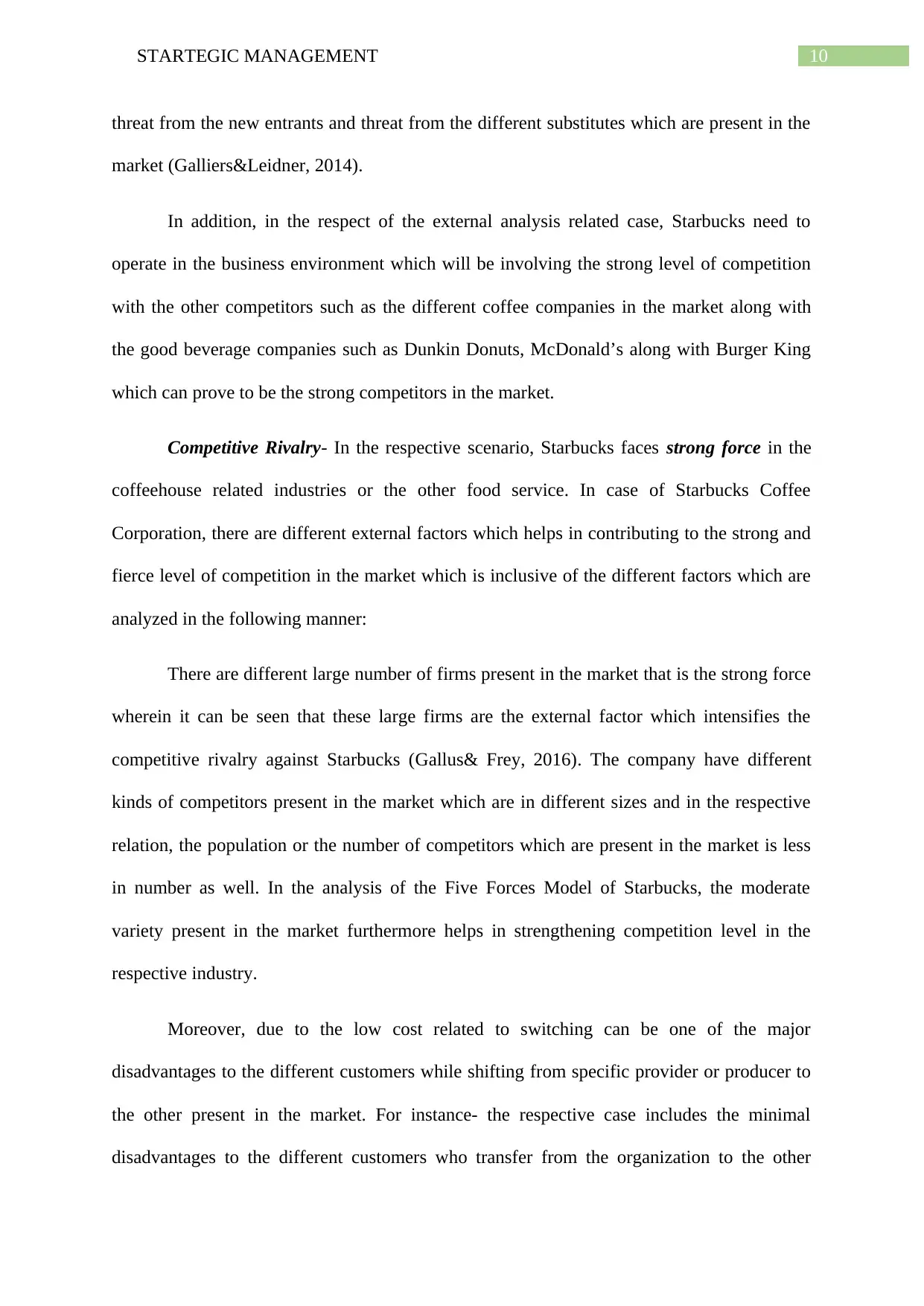
10STARTEGIC MANAGEMENT
threat from the new entrants and threat from the different substitutes which are present in the
market (Galliers&Leidner, 2014).
In addition, in the respect of the external analysis related case, Starbucks need to
operate in the business environment which will be involving the strong level of competition
with the other competitors such as the different coffee companies in the market along with
the good beverage companies such as Dunkin Donuts, McDonald’s along with Burger King
which can prove to be the strong competitors in the market.
Competitive Rivalry- In the respective scenario, Starbucks faces strong force in the
coffeehouse related industries or the other food service. In case of Starbucks Coffee
Corporation, there are different external factors which helps in contributing to the strong and
fierce level of competition in the market which is inclusive of the different factors which are
analyzed in the following manner:
There are different large number of firms present in the market that is the strong force
wherein it can be seen that these large firms are the external factor which intensifies the
competitive rivalry against Starbucks (Gallus& Frey, 2016). The company have different
kinds of competitors present in the market which are in different sizes and in the respective
relation, the population or the number of competitors which are present in the market is less
in number as well. In the analysis of the Five Forces Model of Starbucks, the moderate
variety present in the market furthermore helps in strengthening competition level in the
respective industry.
Moreover, due to the low cost related to switching can be one of the major
disadvantages to the different customers while shifting from specific provider or producer to
the other present in the market. For instance- the respective case includes the minimal
disadvantages to the different customers who transfer from the organization to the other
threat from the new entrants and threat from the different substitutes which are present in the
market (Galliers&Leidner, 2014).
In addition, in the respect of the external analysis related case, Starbucks need to
operate in the business environment which will be involving the strong level of competition
with the other competitors such as the different coffee companies in the market along with
the good beverage companies such as Dunkin Donuts, McDonald’s along with Burger King
which can prove to be the strong competitors in the market.
Competitive Rivalry- In the respective scenario, Starbucks faces strong force in the
coffeehouse related industries or the other food service. In case of Starbucks Coffee
Corporation, there are different external factors which helps in contributing to the strong and
fierce level of competition in the market which is inclusive of the different factors which are
analyzed in the following manner:
There are different large number of firms present in the market that is the strong force
wherein it can be seen that these large firms are the external factor which intensifies the
competitive rivalry against Starbucks (Gallus& Frey, 2016). The company have different
kinds of competitors present in the market which are in different sizes and in the respective
relation, the population or the number of competitors which are present in the market is less
in number as well. In the analysis of the Five Forces Model of Starbucks, the moderate
variety present in the market furthermore helps in strengthening competition level in the
respective industry.
Moreover, due to the low cost related to switching can be one of the major
disadvantages to the different customers while shifting from specific provider or producer to
the other present in the market. For instance- the respective case includes the minimal
disadvantages to the different customers who transfer from the organization to the other
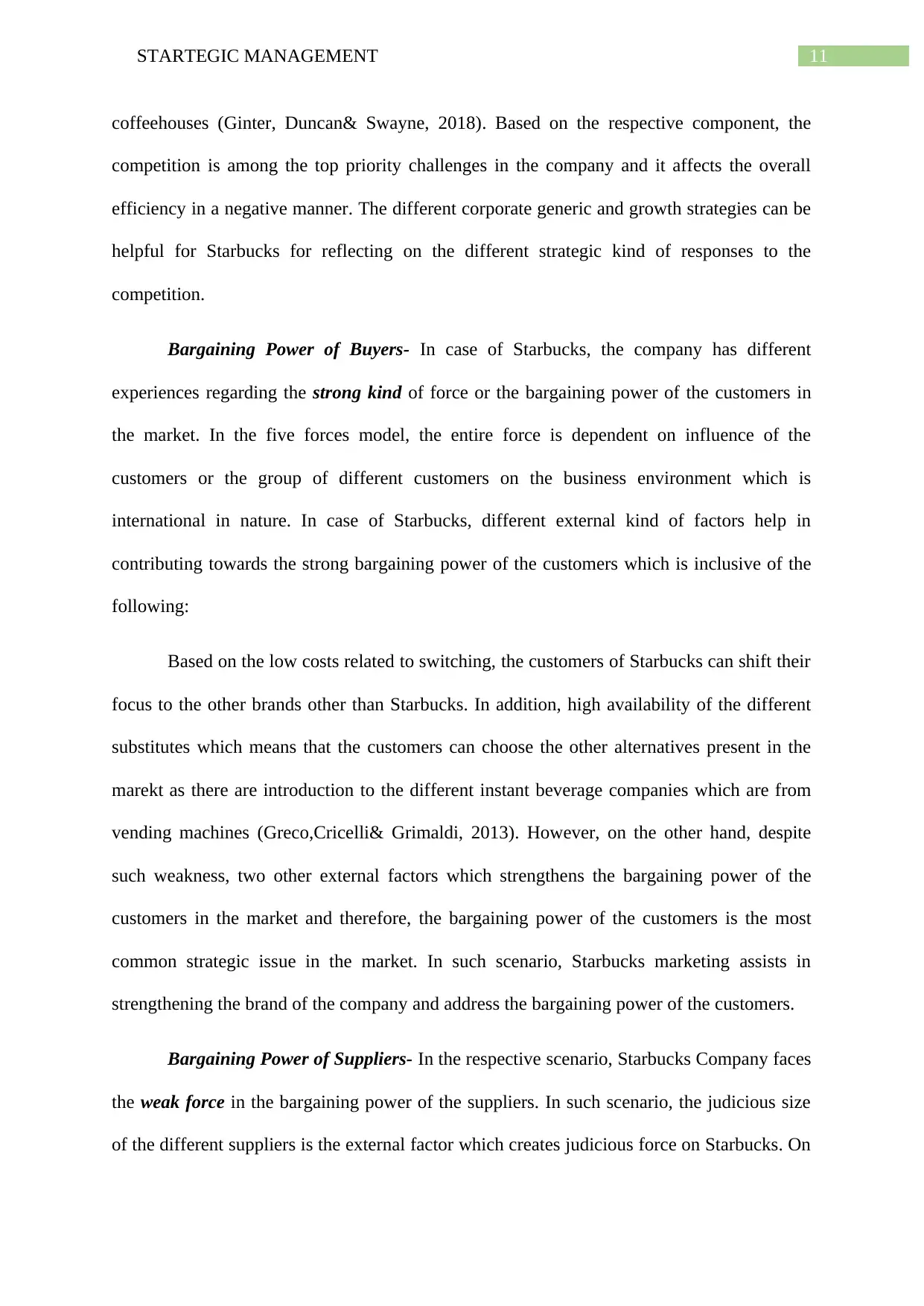
11STARTEGIC MANAGEMENT
coffeehouses (Ginter, Duncan& Swayne, 2018). Based on the respective component, the
competition is among the top priority challenges in the company and it affects the overall
efficiency in a negative manner. The different corporate generic and growth strategies can be
helpful for Starbucks for reflecting on the different strategic kind of responses to the
competition.
Bargaining Power of Buyers- In case of Starbucks, the company has different
experiences regarding the strong kind of force or the bargaining power of the customers in
the market. In the five forces model, the entire force is dependent on influence of the
customers or the group of different customers on the business environment which is
international in nature. In case of Starbucks, different external kind of factors help in
contributing towards the strong bargaining power of the customers which is inclusive of the
following:
Based on the low costs related to switching, the customers of Starbucks can shift their
focus to the other brands other than Starbucks. In addition, high availability of the different
substitutes which means that the customers can choose the other alternatives present in the
marekt as there are introduction to the different instant beverage companies which are from
vending machines (Greco,Cricelli& Grimaldi, 2013). However, on the other hand, despite
such weakness, two other external factors which strengthens the bargaining power of the
customers in the market and therefore, the bargaining power of the customers is the most
common strategic issue in the market. In such scenario, Starbucks marketing assists in
strengthening the brand of the company and address the bargaining power of the customers.
Bargaining Power of Suppliers- In the respective scenario, Starbucks Company faces
the weak force in the bargaining power of the suppliers. In such scenario, the judicious size
of the different suppliers is the external factor which creates judicious force on Starbucks. On
coffeehouses (Ginter, Duncan& Swayne, 2018). Based on the respective component, the
competition is among the top priority challenges in the company and it affects the overall
efficiency in a negative manner. The different corporate generic and growth strategies can be
helpful for Starbucks for reflecting on the different strategic kind of responses to the
competition.
Bargaining Power of Buyers- In case of Starbucks, the company has different
experiences regarding the strong kind of force or the bargaining power of the customers in
the market. In the five forces model, the entire force is dependent on influence of the
customers or the group of different customers on the business environment which is
international in nature. In case of Starbucks, different external kind of factors help in
contributing towards the strong bargaining power of the customers which is inclusive of the
following:
Based on the low costs related to switching, the customers of Starbucks can shift their
focus to the other brands other than Starbucks. In addition, high availability of the different
substitutes which means that the customers can choose the other alternatives present in the
marekt as there are introduction to the different instant beverage companies which are from
vending machines (Greco,Cricelli& Grimaldi, 2013). However, on the other hand, despite
such weakness, two other external factors which strengthens the bargaining power of the
customers in the market and therefore, the bargaining power of the customers is the most
common strategic issue in the market. In such scenario, Starbucks marketing assists in
strengthening the brand of the company and address the bargaining power of the customers.
Bargaining Power of Suppliers- In the respective scenario, Starbucks Company faces
the weak force in the bargaining power of the suppliers. In such scenario, the judicious size
of the different suppliers is the external factor which creates judicious force on Starbucks. On
⊘ This is a preview!⊘
Do you want full access?
Subscribe today to unlock all pages.

Trusted by 1+ million students worldwide
1 out of 31
Related Documents
Your All-in-One AI-Powered Toolkit for Academic Success.
+13062052269
info@desklib.com
Available 24*7 on WhatsApp / Email
![[object Object]](/_next/static/media/star-bottom.7253800d.svg)
Unlock your academic potential
Copyright © 2020–2025 A2Z Services. All Rights Reserved. Developed and managed by ZUCOL.




